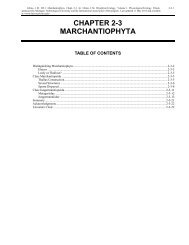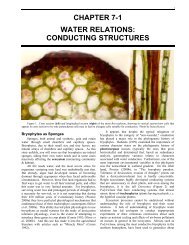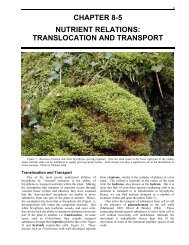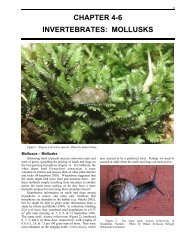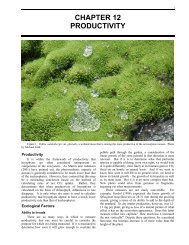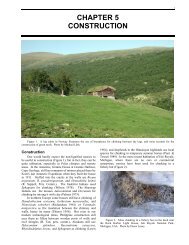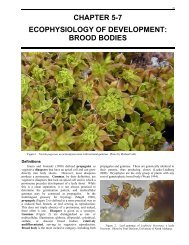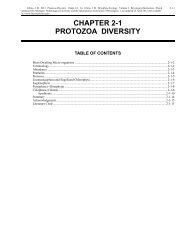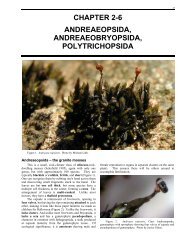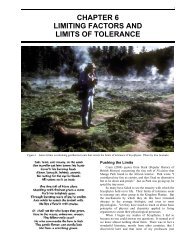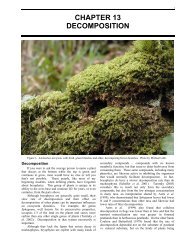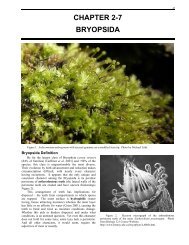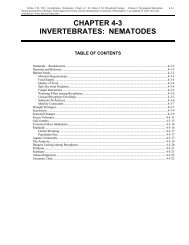Chapter 4-5 Invertebrates Rotifers - Bryophyte Ecology - Michigan ...
Chapter 4-5 Invertebrates Rotifers - Bryophyte Ecology - Michigan ...
Chapter 4-5 Invertebrates Rotifers - Bryophyte Ecology - Michigan ...
You also want an ePaper? Increase the reach of your titles
YUMPU automatically turns print PDFs into web optimized ePapers that Google loves.
4-5-16 <strong>Chapter</strong> 4-5: <strong>Invertebrates</strong>: <strong>Rotifers</strong>Figure 59. Testudinella patina; some members of this genusare Antarctic moss dwellers. Photo by Yuuji Tsukii.Peatland HabitatsSphagnum seems to be as important for rotifers as it isfor micro-organisms. Unique communities characterize thevarious stages in the peatland ecosystem (Francez &Devaux 1985). Some rare species can be common amongSphagnum. That is the case for the rare Tetrasiphonhydrocora in Lac des Femmes, Quebec, Canada (Norgrady(1980). One reason for the occurrence of rare speciesamong Sphagnum may be its ability to serve as a safesite/refugium against predators (Kuczyńska-Kippen 2008).In a poor fen in Newfoundland, Canada, Bateman andDavis (2007) found 25 bdelloid and 39 monogonontrotifers. Among these, 27 were new records for Canadaand 13 new for North America. They found an average of354 rotifers per cm 2 and 17 species per formation. Thesewere seasonal, with the monogononts almost vanishing inwinter. The bdelloids decreased, but not so dramatically.The hummocks and hollows present very differentmoisture and temperature regimes, and this is representedby differences in rotifer species (Bateman & Davis 2007).The summits of the hummocks were predominatelybdelloid rotifers, although these never became desiccated,with the number of monogononts increasing in bothspecies richness and numbers of individuals on the slopes,reaching their greatest numbers in the hollows.As the peatland water content decreases, the faunabecome less like that of open water. Among peat mosses,the species with the highest percentage of characteristicrotifer species is the oligotrophic Sphagnum angustifolium(Figure 60) of low moors (Francez & Devaux 1985). Pejlerand Bērziņš (1993) found most bdelloids need lots ofoxygen, but some survive in soft bottom sediments. Thediversity of habitats in bogs results in several speciespreferring the bog ecosystem.Many rotifers are missed during casual observancebecause their size is less than 200 µm (Gilbert & Mitchell2006). Some are missed because they hide inside hyalinecells of Sphagnum leaves and stems, entering through thepores (Hingley 1999), or in outer branch cells (May 1989).Some rare species can be found in peatlands, rare perhapsbecause that habitat has not been sampled as much forrotifers. For example, Tetrasiphon hydrocora was notuncommon in association with Sphagnum in Lac desFemmes, Quebec, Canada, yet seemed to be generally rare(Norgrady 1980). It likewise was one of the rotifersreported in the peatland study by Hingley (1993) .Figure 60. Sphagnum angustifolium, the oligotrophicspecies in low moors with the highest percentage of rotiferspecies. Photo by Michael Lüth.As noted, the Bdelloidea are the dominant group, inpeatlands mostly represented by the genera Philodina(Figure 61-Figure 62) and Habrotrocha (Figure 63)(Gilbert & Mitchell 2006). Among the Monogononta,peatlands are occupied mostly by Colurella (Figure 29),Euchlanis (Figure 66-Figure 65), Lecane (Figure 68-Figure 67), and Trichocerca (Figure 7) (Gilbert & Mitchell2006). Francez (1981), who identified 142 species inpeatlands, found that in France both abundance and averagesize were greater in fens than in bogs. Many kinds ofrotifers are unable to live among peat mosses because ofthe high degree of acidity (Hingley 1993).Figure 61. Philodina on the alga Spirogyra. Photo by YuujiTsukii.Figure 62. Extended Philodina. Photo by Jean-MarieCavanihac at Micscape.



